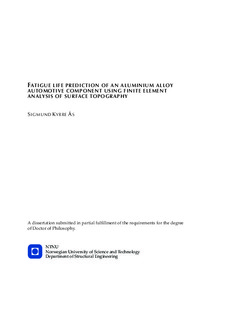| dc.contributor.advisor | Skallerud, Bjørn | nb_NO |
| dc.contributor.advisor | Tveiten, Bård Wathne | nb_NO |
| dc.contributor.author | Ås, Sigmund | nb_NO |
| dc.date.accessioned | 2014-12-19T11:25:05Z | |
| dc.date.available | 2014-12-19T11:25:05Z | |
| dc.date.created | 2006-08-28 | nb_NO |
| dc.date.issued | 2006 | nb_NO |
| dc.identifier | 125983 | nb_NO |
| dc.identifier.isbn | 82-471-7790-0 | nb_NO |
| dc.identifier.uri | http://hdl.handle.net/11250/231306 | |
| dc.description.abstract | A 6082 aluminium alloy has been characterized with regard to the influence of surface roughness on fatigue strength.
Fatigue life testing of smooth specimens was used to establish reference curves for the material in extruded and forged T6 condition. The extruded material was found to have better fatigue strength than the forged material, although the cyclic stress-strain response was similar for both. The forged material was tested in T5, T6 and T7 tempers, showing no significant difference in fatigue strength.
Surface roughness was created by circumferential grinding of cylindrical test specimens, and the surface topography was measured using a white light interferometry microscope. The measurements proved to be accurate, although errors were observed for certain surface features. Residual stresses were quantified by X-ray diffraction. Compressive residual stresses of around 150 MPa were found in both rough and smooth specimens. Load cycling did not significantly alter the surface residual stresses.
Stress solutions ahead of all major surface grooves were found using a linear elastic material model. Estimates of cyclic stresses and strains were calculated in the notch roots using different Neuber corrections of the linear solution. The results were compared to finite element analysis employing a bilinear kinematic hardening model. A generalized version of the Neuber correction was found to be within 20% of the nonlinear finite element results.
Several empirical models for the notch sensitivity factor were investigated. These were found to be unable to describe the notch influence on fatigue life and initiation life. In order to follow this approach, it was recommended that different test specimens should be used where the short fatigue crack growth could be monitored.
It was shown that microstructural fracture mechanics theories could be used to estimate the fatigue limit of rough surfaces. In some cases, initiation from material defects or weaknesses would override the influence of surface geometry. In one specimen, the initiation appeared to have started as at a de-bonded grain, while in other cases, initiation was thought to have started at larger second phase particles embedded in notch roots. Further work in this area should focus on statistical descriptions of surface roughness, inherent material defects, and their interaction. | nb_NO |
| dc.language | eng | nb_NO |
| dc.publisher | Fakultet for ingeniørvitenskap og teknologi | nb_NO |
| dc.relation.ispartofseries | Doctoral Theses at NTNU, 1503-8181; 2006:25 | nb_NO |
| dc.subject | mechanical engineering | en_GB |
| dc.subject | fatigue | en_GB |
| dc.subject | automotive | en_GB |
| dc.subject | surface roughness | en_GB |
| dc.subject | white light interferometry | en_GB |
| dc.subject | finite element method | en_GB |
| dc.subject | aluminium | en_GB |
| dc.subject | TECHNOLOGY: Engineering mechanics: Mechanical and thermal engineering | en_GB |
| dc.title | Fatigue Life Prediction of an Aluminium Alloy Automotive Component Using Finite Element Analysis of Surface Topography | nb_NO |
| dc.type | Doctoral thesis | nb_NO |
| dc.source.pagenumber | 195 | nb_NO |
| dc.contributor.department | Norges teknisk-naturvitenskapelige universitet, Fakultet for ingeniørvitenskap og teknologi | nb_NO |
| dc.description.degree | PhD i konstruksjonsteknikk | nb_NO |
| dc.description.degree | PhD in Structural Engineering | en_GB |
